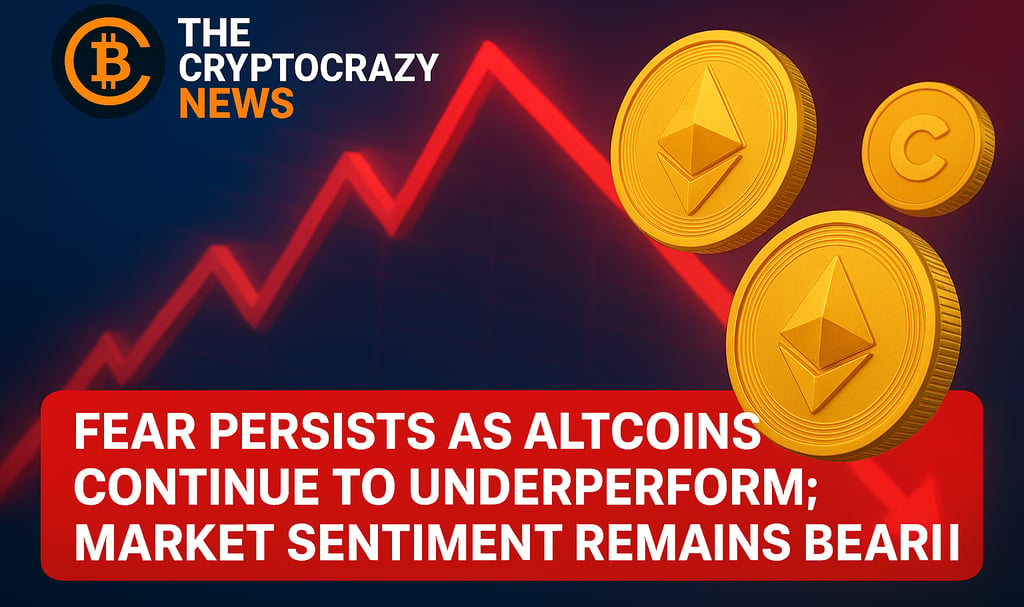Altcoin Market Faces Pressure Amid Risk-Off Sentiment, Massive Liquidations, and Stablecoin Regulatory Uncertainty
The crypto market experienced fresh volatility this week as risk-off sentiment from the traditional financial markets, altcoin-focused liquidations, and regulation uncertainty surrounding stablecoin laws took a toll on investor sentiment. While Bitcoin remained relatively firm, the altcoin space has been unable to sustain momentum, with steep declines across leading tokens and a significant decline in total trading volume.
10/22/20252 min read


Market analysts refer to this as a "perfect storm" of macroeconomic pressures and crypto-specific headwinds, setting the stage for a wary climate for investors and traders alike.
Global Risk-Off Sentiment Strikes Crypto Markets
Traditional markets have moved into risk-off mode after global economic uncertainties, such as the increase in bond yields, inflation fears, and geopolitical tensions. Such a risk-averse investor sentiment has spilled over to the cryptocurrency market, where speculative assets such as altcoins tend to be the first ones that are pulled back.
As investors re-directed funds into safer assets like the U.S. dollar and Treasury bills, liquidity in the crypto market has tightened up. "When there is uncertainty in traditional markets, digital assets tend to have exaggerated responses," said one analyst. "Altcoins being riskier tend to absorb the maximum hit."
Altcoin Liquidations Contribute to Selling Pressure
Figures from top crypto derivatives exchanges indicate that more than $200 million in worth of leveraged altcoin positions have been closed out in the past 48 hours alone. Ethereum, Solana, Cardano, and Avalanche were some of the worst affected, with traders succumbing to margin calls and compelled sell-offs.
This liquidation wave set off a domino effect on exchanges, amplifying downward momentum. Analysts point out that these events tend to induce short-term fright but also can lay the foundation for possible accumulation phases once volatility recedes.
Stablecoin Legislation Introduces Layer of Uncertainty
Adding to the market's troubles is new regulatory risk over stablecoins, with a number of governments — including the United States and Japan — indicating closer regulation. New pieces of legislation seek to place tighter conditions on reserves, disclosure, and operational models for stablecoin issuers.
Though meant to improve consumer protection and market stability, the uncertainty in regulatory guidelines has unsettled investors in the short term. "Stablecoins are the backbone of crypto liquidity," explained a blockchain policy expert. "Uncertainty in this space creates ripple effects across the entire digital asset ecosystem."
Analyst Insights: Short-Term Pain, Long-Term Gain?
In spite of the present decline, most analysts see this correction as a wholesome market rebalancing and not a long-term bearish trend. They cite the ongoing increase in institutional demand for digital assets, ongoing blockchain development, and the fundamental long-term appeal of decentralized finance (DeFi) as drivers of potential recovery.
One research note states:
"Volatility is to be expected at times of transition. Once regulatory certainty increases and macroeconomic stability sets in, we look for altcoins to get stronger again — possibly giving rise to a new wave of capital inflows."
What's Next for Altcoins?
Traders are now keeping a close watch on crucial support levels for Ethereum, Solana, and other large altcoins. A break below current levels would start another bout of selling, while hints at stabilization in conventional markets could offer a much-needed shot in the arm to crypto sentiment.
Meanwhile, market players are best placed to remain vigilant, tread carefully with leverage, and keep track of regulatory events that may affect stablecoin liquidity and overall market stability.
Conclusion
The recent risk-off sentiment, liquidation stress, and regulatory ambiguity have made it tough for altcoins. Nevertheless, with fundamentals of the sector still intact and increasing institutional interest in blockchain technology, most believe the current phase could be a strategic buying opportunity for long-term investors.
As world markets adapt to changing economic and policy trends, everyone's attention is still on whether the cryptocurrency market can ride it out — and come out on top once clarity sets in.
